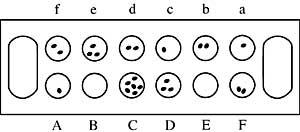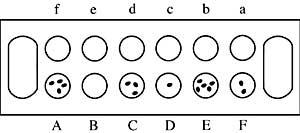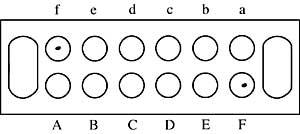Mancales
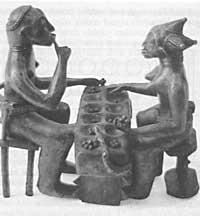
We keep looking for games all over the world. This time we go to Africa. In it we could see different versions of the type of game called Mankala. However, in all versions the idea of sowing seeds, stones, etc., one by one, in holes made in the soil or in a table is maintained.
The word mankala comes from Arabic. Mangala-magala or naqala means to move. The game comes from Egypt, where tables of more than 3,500 years have been found around Kamat, Luxor and Kurna. There are many mancal games, H. J. R. Murray quotes in his book A History of Board-Games Other Than Chess (Oxford University Press, 1952) about two hundred versions.
In addition to Africa, there are also mancal games in Oceania, Asia and America. It was introduced by slaveholders in America. Although different local names are used, they have the same origin.
First, we will make a complete description of the Awari de las Antillas. Then, considering that the rules are similar, we will make a somera description of other games like Mbau, Bao or Hus.
1 Awari
The Awari board has two rows of six holes, one larger at the ends to keep the pieces trapped. The pieces are seeds or chants of chickpea size, 48 in total.
The two players are located on the sides of the board. Each has six holes on its side and its right hole. Four pieces are placed in the twelve starting holes (see figure 1).

The starting player takes all the seeds from any hole on his side and sows them in the adjacent holes, one by one, against the clockwise direction (see figure 2).
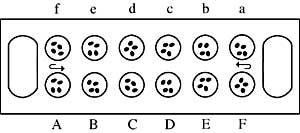
In the example of figure 3, the PLAYER has taken the seeds from hole D and planted them in holes a and b of the opposite, E, F. As can be seen in Figure 4, the player takes the seeds from the pit and sembra them in pits A, B, C and D.
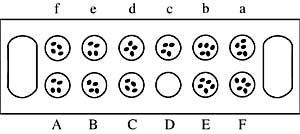
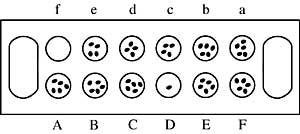
So on. In some hole there may be 12 or more seeds. So if you pick the seeds from there the player would turn the board completely. In this case no seeds will be sown in the hole mentioned
If leaving the last seed sown in a hole in favor of the opposing player there are two or three seeds left, the player who has moved it will take those two or three seeds and take them to his lair. If in the next and previous holes of the mentioned hole there were 2 or 3 seeds, they would also be trapped and so until they find in a hole less than two or more than three. No seed can be captured if it stays in a hole in favor of the player who has moved the last seed or if more than one or three seeds are left in the opposing player's hole. If in figure 5 the PLAYER takes the six seeds of hole E and sows them in the following (see figure 6), when sowing the last seed in hole e, the PLAYER will capture them and the two of f, the two of d and the three of c, leaving the table as in figure 7.
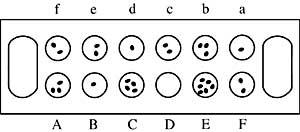
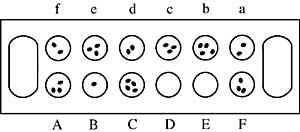
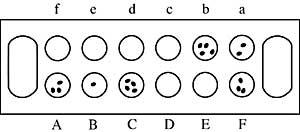
We have several special situations:
a) Players cannot empty all holes in favor of the opponent. In figure 8 the PLAYER, starting from hole C, would catch all the seeds of the opposite. So you will have to start from another hole. However, if from any hole a player had to catch all the seeds of the opponent, he would not have played and the move would end. Then each player would take his seeds to his den.
Figure .
b) If a player's holes are empty, the player who will move (if possible) must sow something in them. Suppose the player has his only seed in the pit f and has to sow in the pit A (see figure 9).
Figure .
The other PLAYER must leave through holes E or F, as it will sow something in the holes of the former. In the case of the situation in figure 10, the PLAYER does not have the possibility to sow the seeds in the holes on the other side. Therefore, the game will be finished and this PLAYER will take the seeds to his den.
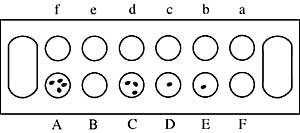
c) If there are few seeds left without catching possibilities (see figure 11), the game will end and each player will bring their seeds to the lair.
Figure .
As already indicated, the game will end if no more seeds can be captured or a player cannot move. Then, the seeds of the guards will be counted and won over. The move can end sooner if a player reaches more than half (24) of the seeds.
Mbau
On his trip to Kenya, we saw some men playing Mbau in a corner of Shela near Lamu. After a while watching, we realized that we did not learn. We asked them to teach and taught us that we played a match.
In this game players take the stones from the 16-hole board. In the beginning there are 32 stones placed as can be seen in figure 12. Each player takes the stones from a hole on their side and places them in the following holes against the clockwise direction. If the last stone placed (cannot be left in the holes on the player's side in the first move) falls into a hole that is not empty, take that stone and those in the hole and, as before, continues to be placed in the following holes. So on until the last stone falls into the hollow. If this empty hole is in favor of the player who has moved it, the player can eject all the stones from the holes in the empty hole and on the contrary, located in front of all the empty holes next to him (see figure 12). Whoever first expels 17 stones will win.
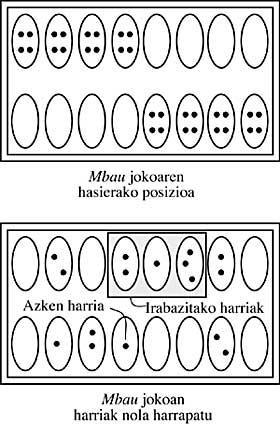
Vain
In the African Heritage organization of Nairobi we asked about the previous game and they gave us a brooch with another game that is played in the same table:
Bob means board in kiswahili. In the game two people intervene in a table (vain) with 12, 16, 24 or 32 holes (shimo). In the 16-hole table, which we'll use here, players have 18 stones (stakes). Divided into six groups of three units (mtajis), they are arranged in six holes.
Figure 13 shows the initial position.
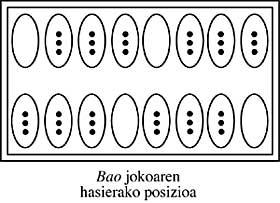
The key to the gap is savings in distribution. In fact, players will try to leave at least two stones in each hole (a team consists of at least two stones). If in all holes you do not get a group (at least two stones), the opponent can make house (Nyumba). The winner is the one that catches the most stones.
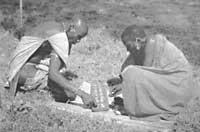
In the vain game there are three types of movements: cutacata, capture and marriage. The first turn is made to stick.
- The kutakata is the opening of all shifts (not just the first). At the opening the players make two moves against the clockwise direction. The player takes the team from a hole in his favor and divides them into the following holes, one by one, ending a move. If you leave the last stone in a hole, the turn ends. On the contrary, if you leave a group in the hole in which it is located, take the stones and the last stone of the place and continue to distribute it, following another movement. So on until the last stone remains in the hole. If from the second movement (including the second) the last stone falls into the hole of a single stone, it forms a house (nyumba) (two stones).
- The houses are formed if the last stone falls into the hole that only has a stone. Houses can only be completed after opening. Players can complete their homes on both sides of the table. When this happens, the player does not separate the two stones from the house, but leaves them there, once the round is over. If any of the players fall into a stone house, it will remain there until the end of the game and is considered a trapped stone, being a point for the owner of the house.
- Capture is the fastest way to collect points. The last stone falls into the hole in favor of the player. If this gap is in front of a team, the player will eject the stones from the board. (Except in the first opening movement). If the player does not know how to catch stones, he will try to make a house or look for the possibility of moving at least, so that a team is kept in all holes. The only case players cannot catch is that there is a house in front of the empty hole. That is why houses are important.
In this footboard there was also a more complete version of Bao La Kiswahili, but without precision (initial position, number of stones, certain rules, etc. ). ). Therefore, we have decided not to appear here.
Hus 2

We were not happy with the differences from the previous two games that bear a similar name and went to the Kenyan National Library in Nairobi. There, R. C. In Bell we find a work on the games of two units. In the second issue, under the name of mancal, appeared a series of African games in which all were played with stones or balls and holes made in sand or boards.
Below we will explain what is played in the table we saw in Lamun, which is called Hus. The book said the hotentotes from East Africa and South Africa were playing. It seems that C. Created between 1450-1800. Unlike other mancal games, in this version the stones do not leave the table. Figure 14 shows the initial position of the Hus game.
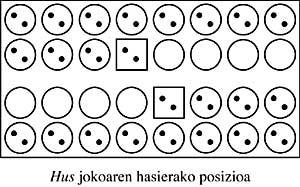
Standards:
- The first is decided by lot. A match consists of several hands. In all hands starts the same player.
- All movements are in favor of the clock needle meaning and are made in two rows (center-exterior) in favor of each player.
- A player takes the two stones from a hole in his favor and places them in the following, one by one. If the last stone falls into the hole, the turn ends.
- If the last stone falls into the hole, it will take all the stones (including the new one) and continue to be placed in the following holes.
- If the process ends in the center line hole and the center line hole of the front opponent is full, the player will replace his stones with those opponent stones and will continue to be placed in the holes on his side. In the same turn you can take the desired catches.
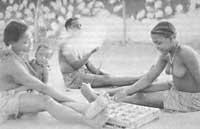 Hot women play in the late afternoon hus. This four-row game is played in South Africa and Ekiafrica, but some experts claim it is originally Arabic.
Hot women play in the late afternoon hus. This four-row game is played in South Africa and Ekiafrica, but some experts claim it is originally Arabic. - If by catching a player in a hole in the center line of the opposite, the corresponding hole in the outer line of the opposite would be full, the player would win the stones of the two holes of the opposite and, in addition, any hole of the opposite (of a hole). It will place all the stones trapped in the holes on its side, starting with the next hole in which the capture has been made.
- The movements will begin with a hole of two or more stones, and if only the holes of a stone were, it could not move and would lose the move.
- If a player draws all the stones from the opposite, it would be considered a double victory.
- The match will win in seven hands.
In the game Hus it is worth noting how fast the luck changes.
Buletina
Bidali zure helbide elektronikoa eta jaso asteroko buletina zure sarrera-ontzian




